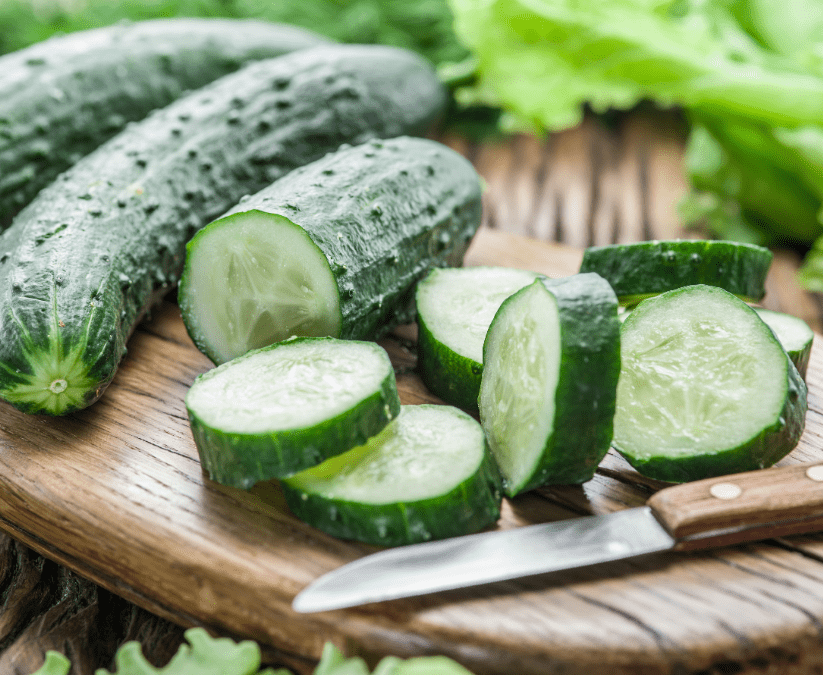Cool as a cucumber; that’s a phrase many of us are familiar with when describing someone who has an easy-going vibe even when the pressure is mounting. But why a cucumber? Well, because of their high water content, cucumbers are known to feel cool and refreshing to the touch even when it is hot outside. During San Antonio summers, that sure can be a welcome reprieve. Let’s talk about all you need to grow these “chill” veggies so you can enjoy fresh cucumbers all summer long.
Choosing your Cucumbers:
Choose the type of cucumber you grow based on what you want to use it for. If you want a bushel of pickles, choose smaller varieties that average out to 4-6″ in length. If you prefer your cucumbers crisp and fresh for topping salads, choose slicing varieties that grow to an average length of 8-10″. This doesn’t mean that you can’t pickle a slicing cucumber. There is just a difference you may notice in texture, inner structure, and quality. And pickling, or bush varieties can also still be used for slicing and are great if you are limited on space, as they well suited for containers.
So now that I’ve thoroughly confused you, you can heed this advice, or go ahead and pick whichever cucumber looks good to you, or get both types!

Light and Soil Requirements
Cucumbers, like most veggies, require full sun which means at least 6 to 8 hours a day. You simply won’t get the best yields, if any, if your plant gets too much shade.
Ideally a soil depth of 1 ½ to 2 feet is best to accommodate the root system (and deeper is even better). You’ll need 3 cu. ft. for containers. These depths allow for the growth of the extensive root system cucumbers have and offer them better heat protection. Soil that is rich in organic matter, with a pH between 6.0 – 7.0 is also best, along with it being imperative that your soil is well-draining. Cucumbers can’t survive root-rot-inducing “wet feet”.
Soil should also be nice and loose to allow for the extensive root system that cucumbers have; adding plenty of organic matter (compost/soil conditioner) will help with loosening up heavier soil and helping it drain better, as well as helping sandier soil hold a little more moisture. It’s also a good idea to mix in a well balanced fertilizer, like a 1-2- ratio, when preparing your planting areas. Follow instructions on bag.

Planting Tips for Cucumbers
By Seed:
When planting cucumber seeds, timing is crucial. The soil needs to be sufficiently warm for seeds to germinate, ideally above 60°F. It’s best to wait until mid-March, after the danger of frost has passed, to ensure optimal growing conditions. If not, you may risk growing weak plants, or the chance that your seeds may rot before even sprouting.
- Water soil a few days before planting.
- Create small 6″ hills, or clumps, spaced 2-3′ apart, in your garden.
- For each hill, plant 4 to 6 seeds about 1 to 1 ½ inches deep, evenly spaced.
- Once the seedlings emerge and develop their first true leaves, thin them out, leaving the strongest 2 plants per hill. Thin by pinching or cutting unwanted plants off at the soil line to avoid disturbing the roots of the remaining plants. This will ensure that the remaining plants have enough space and resources to thrive.
By Transplants:
If you prefer to use transplants, you will need to take extra care to really try not to disturb the roots. Cucumbers can be particularly prone to transplant shock.
- Space plants approximately 18 – 24 inches apart in rows that are about 4 to 6 feet apart. This spacing allows for adequate air circulation and room for mature growth.
- Fill your planting hole with a liquid starter solution (or diluted ½ strength liquid fertilizer) and let it soak in.
- Then plant your cucumber so that the soil level in the transplant pot is even with the soil in the garden.
Trellising:
Trellising is highly recommended for cucumbers in San Antonio. If you aren’t growing bush varieties, cucumbers will vigorously vine, so take advantage of growing them upright. Trellising saves space, improves air circulation which help prevent foliage disease, and makes seeing any pests and harvesting easier. Use a sturdy trellis, or large tomato cages work great. Once the tendrils start, they will grab on to just about anything close by, so remember, spacing is important so you your plants don’t get all tangled up.

Watering, and Fertilizer Requirements:
Once you’ve watered sufficiently to get your plant’s roots established, maintain consistent moisture by watering deeply once or twice a week, depending on rainfall. Mulching around the base of the plants can help retain moisture and suppress weeds, just don’t mulch too early in spring, because we want that soil warm.
Fertilize cucumbers with a balanced fertilizer that has a 1-2-1 ratio for the numbers on the bag, every 3 to 4 weeks. This will support their vigorous growth and fruit production.
A special note about pollination:
Do what you can to encourage honeybees in your garden to help with pollination of your cucumber plants. Eliminate the use of harmful pesticides, and use organic products only when necessary and only apply during the evenings when honeybees have tucked in for the night. Also, choosing varieties that have both male and female flowers might can help pollination a little easier (but you still need help from the bees). Some of these varieties include: Straight 8, Poinsett, Marketmore, Spacemaster 80 Bush, Homemade Pickles, and Muncher.

Harvesting Tips:
Cucumbers are ready to harvest when they are firm and uniformly green. Pick them regularly, as the more you pick, the more you encourage continuous production. Avoid letting cucumbers over-ripen on the vine, as this can lead to bitterness.
Are you feeling the cool as a cucumber vibe yet? Hope so!
~The Happy Gardener, Lisa Mulroy

